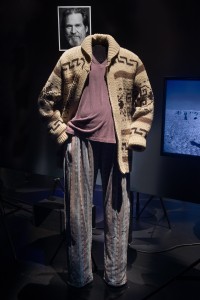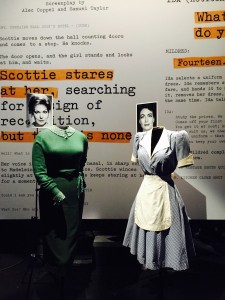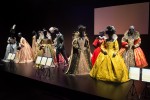This post was updated on Oct. 2 at 3:25 p.m.
In a darkened gallery, beads of light fall on various pieces of clothing, both old and new. A music score swelters up in its intensity and the faces of legendary Hollywood stars are everywhere.
This daze of sight and sound is “Hollywood Costume,” a new exhibit featuring the works of American cinema’s most talented costume designers over the past century. Originally shown at the Victoria and Albert Museum in London, the exhibition will be on display through March 2, 2015 at the Wilshire May Company building.
Covering the early days of silent film melodramas to the most recent superhero blockbusters, visitors can see iconic outfits, such as Charlie Chaplin’s tattered costume and cane from 1915’s “The Tramp” and Judy Garland’s blue-and-white dress and ruby red slippers from 1939’s “The Wizard of Oz,” alongside Jamie Foxx’s green jacket and tan pants from 2012’s “Django Unchained” and Jared Leto’s fur coat from 2013’s “Dallas Buyers Club.”
“The costume designer helps create (characters),” said exhibition curator Deborah Nadoolman Landis, professor and director of the David C. Copley Center for the Study of Costume Design at the UCLA School of Theater, Film and Television. “Movies are about people and it’s our connection with (these people) that makes it so exciting.”

(Courtesy of John Harbaugh)
For Landis, this exhibition is not merely a lesson in film costume history but also a love letter to the cinema and its power in transporting audiences.
“This is not an exhibition about clothes,” Landis said. “This is an exhibition about the movies.”
The ability of costumes to serve not only an aesthetic function but also a narrative one by taking part in this audience transportation becomes a major theme of the entire exhibition.
Featuring iconic items such as John Travolta’s disco suit from 1977’s “Saturday Night Fever” and Jeff Bridges’ “The Dude” costume from 1998’s “The Big Lebowski,” the exhibition emphasizes the importance these costumes had in creating some of cinema’s most beloved characters.
With more than 150 costumes from 126 films, the exhibition surveys a century of Hollywood filmmaking, including Charles Middleton’s gown from the 1936 serial “Flash Gordon,” Kim Novak’s green sweater and skirt from 1958’s “Vertigo,” John Wayne’s red shirt and Levi’s from 1956’s “The Searchers,” Harrison Ford’s leather jacket and fedora from 1981’s “Raiders of the Lost Ark,” Kim Basinger’s black dress from 1997’s “L.A. Confidential” and Jesse Eisenberg’s sweater from 2010’s “The Social Network.”
“Costume design is a key component to cinematic storytelling,” said Martin Roth, the director of the Victoria and Albert Museum. “And this exhibition is the first to fully elongate the often grueling process (of getting a story told), from script to screen.”
Divided into three “acts” in much the same way a traditional film narrative is, “Hollywood Costume” traces the elements that go into creating a costume for a character, how costume design has changed over the years as technological advancements such as sound and color entered the film medium and the dynamic necessary between the director, the costume designer and the individual actors in order to create a memorable costume for a film.

(Ian Colvin/Daily Bruin)
“You’re not going to see just costumes,” said Kerry Brougher, the director of the Academy Museum of Motion Pictures. “You’re going to see these costumes brought back to life and how the characters (of these films) were created.”
Through cutting-edge technology, multiple forms of media surround visitors throughout the exhibit: rear-screen projections, snippets of interviews with filmmakers and costume designers made to look as though they are conversing with one another, informational texts, animations, snippets of screenplays and photographs.
“This is not just a static exhibition,” Brougher said. “It uses technology to send you on a cinematic journey, and you will be moving through the spaces into the dark dream world of cinema.”
